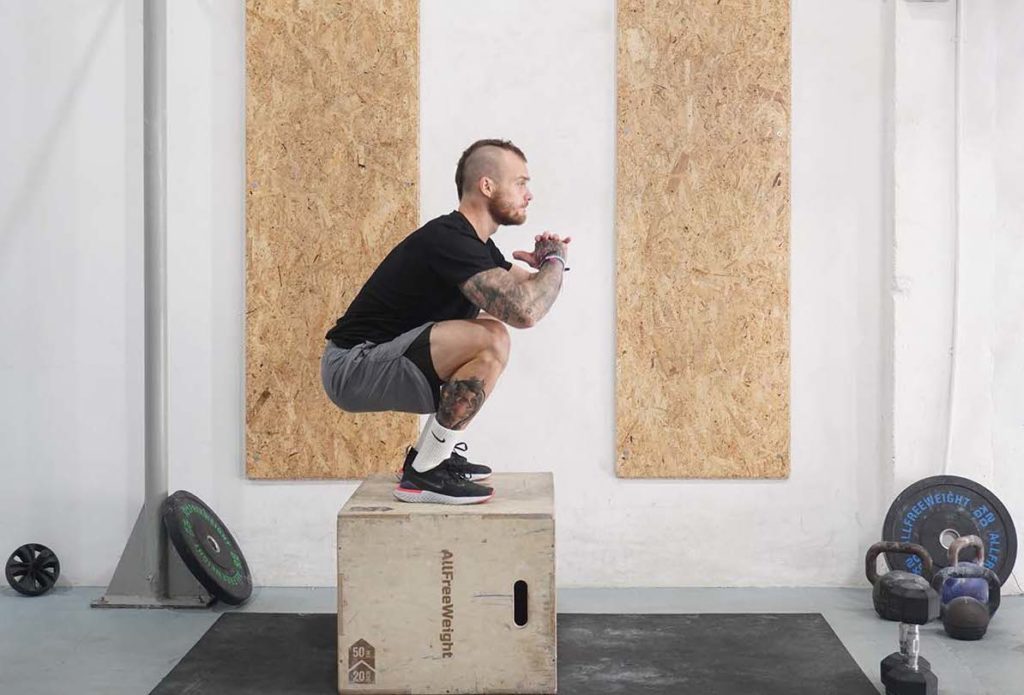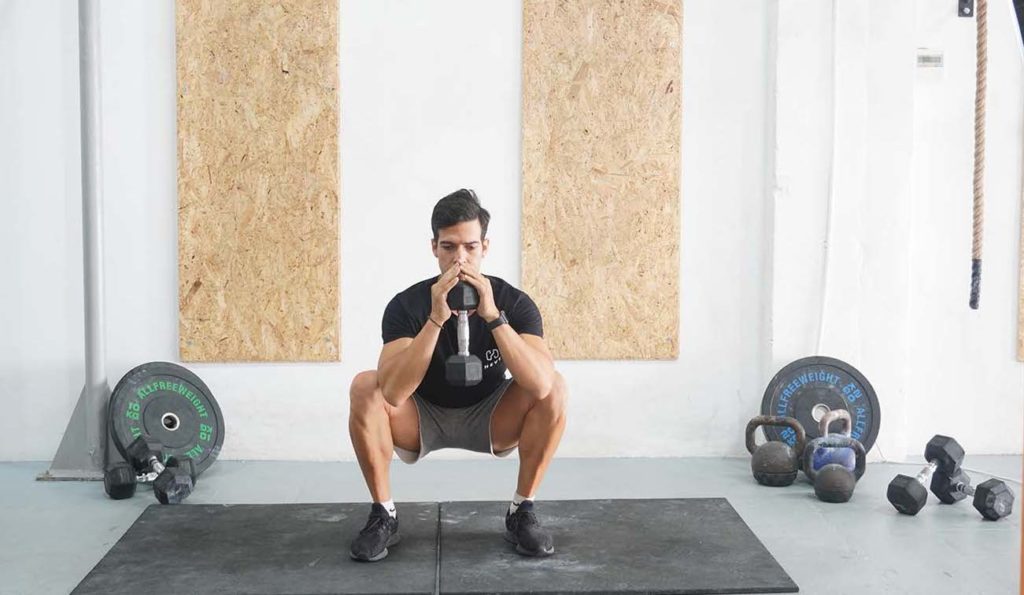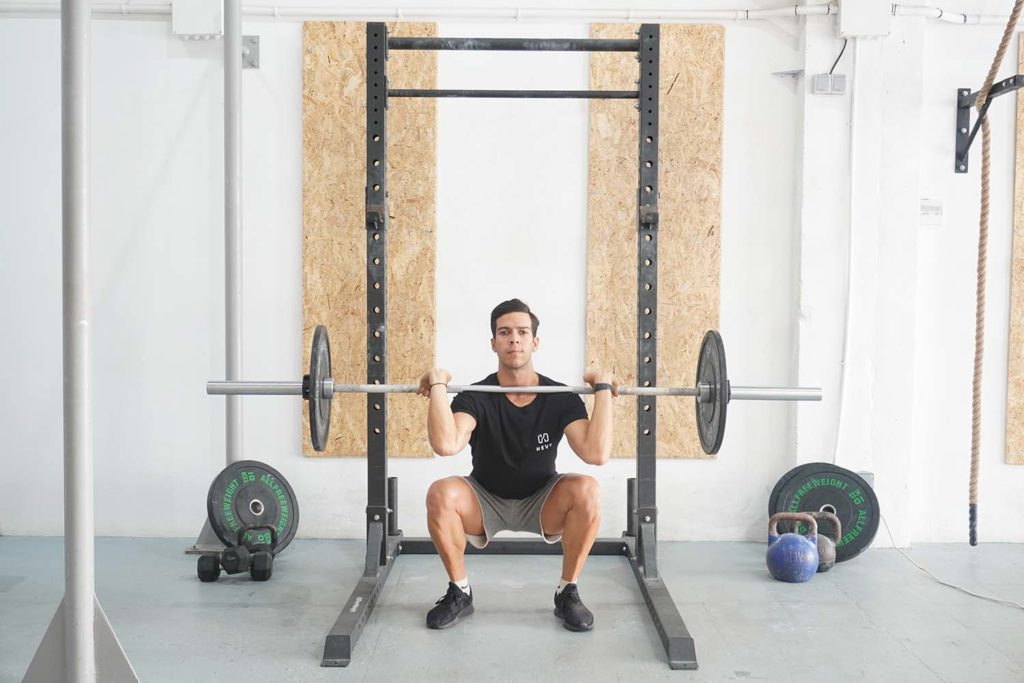What is a jump squat?
The jump squat is an effective bodyweight exercise that builds lower body strength, power, and explosiveness. Unlike classic squats, the jump variation introduces an element of explosiveness off the bottom position. You have to descend and produce lots of force to propel yourself vertically. Doing so recruits many fast-twitch motor units, primed for growth and strength.
Aside from developing strength and power, jump squats also build lower body muscle mass. The movement forces significant activation in the quadriceps, stimulating impressive growth. You can use the jump squat for effective training, even if you don’t have training equipment around.
How you choose to program jump squats into your training will mostly depend on your goals. For example, if you mostly care about strength and muscle mass, you can introduce jump squats later into your workouts as an accessory movement. In contrast, those looking to elevate athletic performance, jump height, and explosiveness should do jump squats as a first or second movement.
How to do a Jump Squat
- Stand tall with your feet at a hip-width level, and toes pointed slightly out.
- Bring your shoulders back and direct your gaze forward. You can have your torso leaning forward slightly.
- Take a breath and hinge at the hips to bring your butt back as you keep your back neutral and bend your knees to descend until your thighs are roughly parallel with the ground.
- As you’re near the bottom, forcefully push through your feet to bolt yourself to the starting position. Make sure to press as hard as you can so that you gain velocity and transition from a squat into a vertical jump. Exhale as you jump.
- As you’re about to land, bend your knees slightly, and immediately descend into another squat as you take another breath.
- Then, follow the same instructions to squat up and transition into another vertical jump.
What muscles does the jump squat activate?
Our quadriceps are the primary muscle that works during a jump squat. The quadriceps cover the front of our thighs and produce knee extension, which occurs as we ascend (1). Unlike regular squats, the jump squat forces significantly higher quadricep activation off the bottom because the muscle group produces more power.
The second muscle group that works during a jump squat is the calves. Our calves cover the rear side of the lower legs, and their primary function is ankle extension (2, 3). As we ascend, our calves produce some force to propel us vertically.
Jump squats also engage your hamstrings and glutes but to a small degree. Both muscle groups play an essential role in hip extension, which occurs as we explode off the bottom and jump vertically (4, 5).
Tips on Proper Form when doing a Jump Squat
A vital tip to remember for jump squats is to make the squat portion of the exercise as smooth as possible. You should descend into a half squat and immediately explode vertically. Doing so would allow you to take advantage of the stretch reflex and accelerate more effectively off the bottom position.
The second tip to keep in mind is that you don’t need to descend until your thighs are parallel to the floor. Many trainees perform at their best from a half-squat position, and doing so prevents your quadriceps from getting too tired, allowing them to produce more force for the jump.
It’s also important to distribute your weight evenly on your entire foot. As you descend, maintain a torso position that allows you to load your heels. You will struggle to maintain balance, and your jump performance will suffer if too much of your weight shifts on your toes.
Variations and Modifications of the Jump Squat
1. Box Jump

Introducing a box to jump squats is a practical way of ensuring that you’re jumping high enough on every repetition. All you have to do is place a plyometric box in front of you (start with no more than six inches), descend, squat, and land on the box.
2. Tempo Jump Squat
Tempo jump squats are beneficial for maintaining proper technique and balance on every repetition. The goal is to descend for a couple of seconds, hold the bottom position, and explode up.
3. Loaded Jump Squat
Loaded jump squats are an advanced variation that allows you to overload your lower body with greater resistance. The most practical way to do the movement is to put a weight vest on yourself. Alternatively, hold a dumbbell in front of your chest, similar to how you would during a goblet squat.
Mistakes to Avoid
A common mistake with jump squats is not warming up effectively. While simple, the jump squat puts some stress on your joints, muscles, and connective tissues, so taking the time to warm them up is essential. Warming up also improves your athletic performance, allowing you to train more productively (6). Some form of cardio and dynamic stretching is often enough.
The second significant mistake with jump squats is introducing external resistance too soon. Many beginners get comfortable with the exercise quickly, so they decide to kick things up a notch by holding a dumbbell or kettlebell. Doing so isn’t ideal because jump squats take time to master. You would be better off doing bodyweight jump squats for at least a few months before adding weight to the equation.
You should also pay careful attention to your breathing because not getting enough oxygen can cut your sets short. Breathe in as you descend, hold your breath at the bottom and exhale as you jump vertically.
Similar Exercises to the Jump Squat
Goblet Squat

Goblet squats are an effective accessory exercise for quadriceps, midsection, and upper back strength. You must hold a dumbbell or kettlebell in front of your chest as you squat. In doing so, you have to maintain a more upright torso, and your upper body has to work extra hard to keep you in position.
Front Squat

Front squats are a more advanced version of the goblet squat because you have to place a barbell in a front rack position. Thanks to the position, your torso is more upright, and less hip extension occurs, allowing you to train your quadriceps more effectively (7).
Lunge (Dumbbell)
Lunges are another effective movement you should introduce to your quadriceps, gluteal, and hamstring training. The goal is to hold a pair of dumbbells, stand tall, bring one leg forward, and bend it at the knee. You then have to push through the front leg to return to the starting position. Unlike most squat variations, lunges are beneficial because they train one leg at a time, ensuring balanced development.
